The 1st Annual Cannabis Quality Conference & Expo featured dynamic discussions both in the sessions as well as on the exhibit floor. Take a look at some of the highlights from this year’s conference and expo.
All image credit: amyBcreative

The 1st Annual Cannabis Quality Conference & Expo featured dynamic discussions both in the sessions as well as on the exhibit floor. Take a look at some of the highlights from this year’s conference and expo.
All image credit: amyBcreative

Among the myriad business challenges facing cannabis companies, processing payroll ranks right up there. On top of the industry’s overarching banking and regulatory hurdles—not to mention prohibitive tax liability—its varied, sometimes unconventional pay models can fall outside the scope of traditional payroll processing.
Obviously, despite the many business issues clamoring for attention, the cannabis industry is powered by people—and for a business to succeed, employees must be paid accurately, legally, and on time.
While the industry is still evolving in many respects, there are steps cannabis businesses can take right now to ensure payroll is processed correctly and compliantly—including these four best practices.
In addition to salaried and hourly employees—who can be difficult to time-track, depending how they’re distributed—some growers pay bud trimmers by the ounce or pound of trimmed, manicured product. While such productivity-based compensation may make absolute sense for your business, most conventional time and attendance and payroll software isn’t equipped to administer this pay model.
As a result, some companies may resort to manual tracking—but that can create regulatory recordkeeping challenges of their own. The answer: flexible time and attendance software that allows companies to track employees’ time and/or productivity using a variety of data collection methods for different elements of the workforce. It may mean using conventional biometric time clocks at processing facilities and retail dispensaries…mobile time-tracking apps for gardeners and growers in the field…and versatile apps that track employee output by work order or piece rate, however your business chooses to define it.
Furthermore, regardless of how it’s collected, all that data needs to flow seamlessly into your payroll processing system, ensuring pay is calculated correctly for every pay model. The HR payroll software is out there, but you may need to look for it.
Perhaps you’ve heard horror stories of cannabis companies getting abruptly dropped by their software providers with a mere 30-days’ notice. Some leading HR payroll software companies have made seemingly overnight decisions to withdraw from servicing the cannabis industry, leaving employers struggling to pay their people. Who can implement new HR payroll software in 30 days?
Make sure your payroll provider is committed to serving the cannabis industry for the long haul. If the commitment isn’t there, start looking elsewhere. Beyond avoiding potentially damaging business disruptions, partnering with a software provider that actively services the cannabis industry will offer unique capabilities you may not find elsewhere.
Thanks to section 280e of Internal Revenue code, state-compliant cannabis business cannot deduct business expenses except for the cost of goods sold (COGS).
The saving grace here for growers and processors: labor costs that are inventorial in nature are considered cost of goods sold. That includes the cleaning, trimming and curing of product, as well as packaging and inventory labor.
Therefore, for tax purposes, it’s critical to assign each employee a specific title and role within your operation. This is particularly important for vertically-integrated companies whose employees wear more than one hat.
Say, an employee works part time in cultivation and part time in your retail dispensary. You need to be able to track their work time and compensation separately—i.e., you need a time and attendance system that can track split shifts—and keep detailed records of what labor costs are and aren’t deductible.
Because of payroll challenges, many cannabis businesses are still piecing together disparate HR systems, such as applicant tracking, time and attendance, payroll and benefits. But when their integration isn’t flawless it can create the need for duplicate inputting and elaborate manual workarounds.
Furthermore, a patchwork software can stop businesses from accessing reports and analytics that inform decision-making and better position the company for growth—while also ensuring the company is in a position to provide whatever regulatory information may be required.
The answer: choose a payroll provider that offers complete, integrated HR payroll software—one that that can demonstrate its long-term commitment to serving the state-licensed cannabis industry.
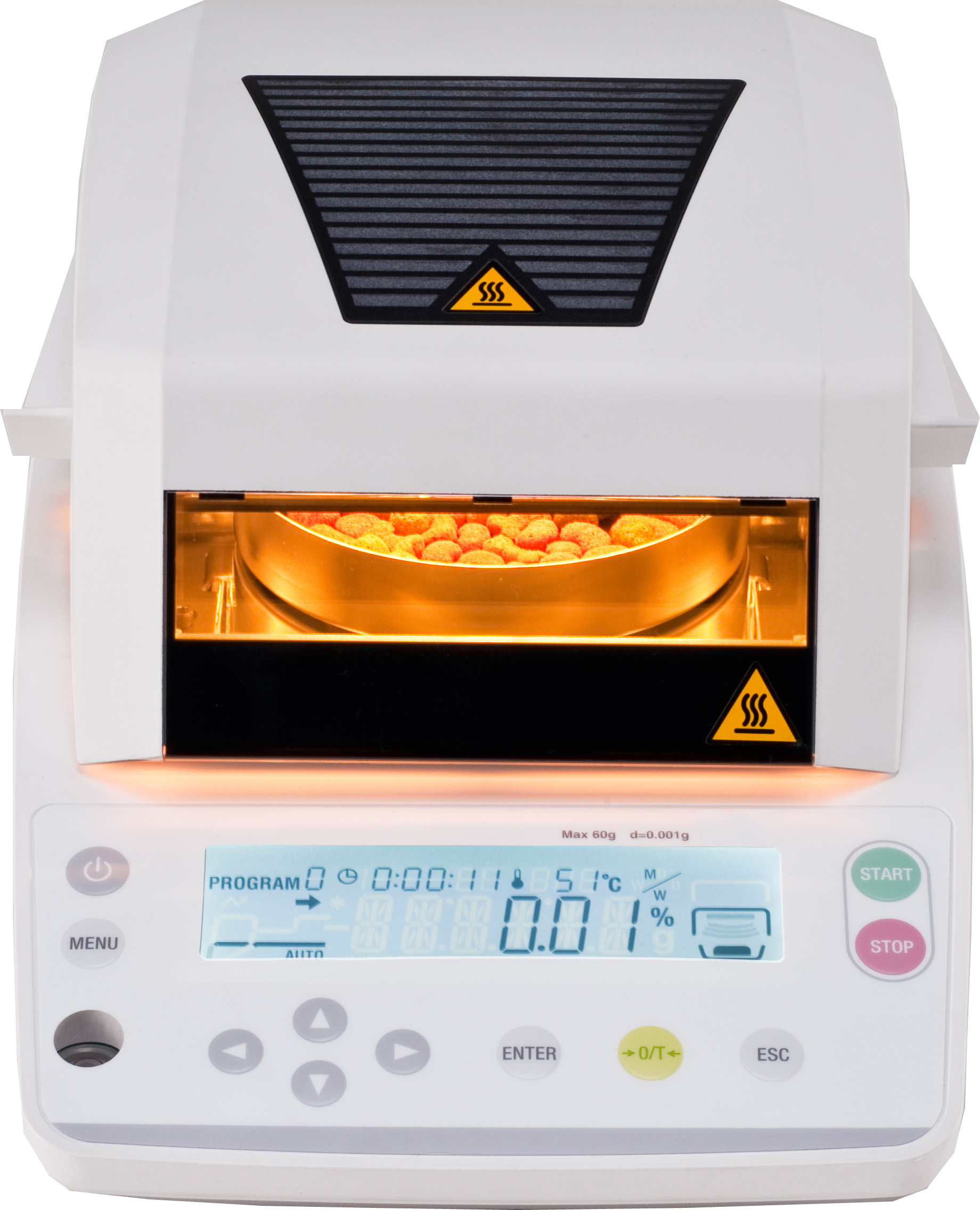
The cannabis industry is growing exponentially, and the use of cannabis for medical purposes is being adopted across the nation. With this boom in cannabis consumers, there has been an increasing need for knowledge about the product.
The role of testing labs has become crucial to the process, which makes owning and operating a lab more lucrative. Scientists testing for potency, heavy metals, pesticides, residual solvents, moisture, terpene profile, microbial and fungal growth, and mycotoxins/aflatoxins are able to make meaningful contributions to the medical industry by making sure products are safe, while simultaneously generating profits and a return on investment.
Here are the key testing instruments you need to conduct these critical analyses. Note that cannabis analytical testing requirements may vary by state, so be sure to check the regulations applicable to the location of your laboratory.

The most important component of cannabis testing is the analysis of cannabinoid profiles, also known as potency. Cannabis plants naturally produce cannabinoids that determine the overall effect and strength of the cultivar, which is also referred to as the strain. There are many different cannabinoids that all have distinct medicinal effects. However, most states only require testing and reporting for the dry weight percentages of delta-9-tetrahydrocannabinol (Δ9-THC) and cannabidiol (CBD). It should be noted that delta-9-tetrahydrocannabinolic acid (Δ9-THCA) can be converted to THC through oxidation with heat or light.
For potency testing, traditional high-performance liquid chromatography (HPLC) is recommended and has become the gold standard for analyzing cannabinoid profiles. Look for a turnkey HPLC analyzer that delivers a comprehensive package that integrates instrument hardware, software, consumables and proven HPLC methods.

Different types of metals can be found in soils and fertilizers, and as cannabis plants grow, they tend to draw in these metals from the soil. Heavy metals are a group of metals considered to be toxic, and the most common include lead, cadmium, arsenic and mercury. Most labs are required to test and confirm that samples are under the allowable toxic concentration limits for these four hazardous metals.
Heavy metal testing is performed by inductively coupled plasma mass spectrometry (ICP-MS). ICP-MS uses the different masses of each element to determine which elements are present within a sample and at what concentrations. Make sure to include accompanying software that provides assistant functions to simplify analysis by developing analytical methods and automatically diagnosing spectral interference. This will provide easy operation and analytical results with exceptionally high reliability.
To reduce running costs, look for a supporting hardware system that reduces the consumption of argon gas and electricity. For example, use a plasma ignition sequence that is optimized for lower-purity argon gas (i.e., 99.9% argon as opposed to more expensive 99.9999%).
The detection of pesticides in cannabis can be a challenge. There are many pesticides that are used in commercial cannabis grow operations to kill the pests that thrive on the plants and in greenhouses. These chemicals are toxic to humans, so confirming their absence from cannabis products is crucial. The number of pesticides that must be tested for varies from state to state, with Colorado requiring only 13 pesticides, whereas Oregon and California require 59 and 66 respectively. Canada has taken it a step further and must test for 96 pesticides, while AOAC International is developing methods for testing for 104 pesticides. The list of pesticides will continue to evolve as the industry evolves.
Testing for pesticides is one of the more problematic analyses, possibly resulting in the need for two different instruments depending on the state’s requirements. For a majority of pesticides, liquid chromatography mass spectrometry (LCMS) is acceptable and operates much like HPLC but utilizes a different detector and sample preparation.

Pesticides that do not ionize well in an LCMS source require the use of a gas chromatography mass spectrometry (GCMS) instrument. The principles of HPLC still apply – you inject a sample, separate it on a column and detect with a detector. However, in this case, a gas (typically helium) is used to carry the sample.
Look for a LC-MS/MS system or HPLC system with a triple quadrupole mass spectrometer that provides ultra-low detection limits, high sensitivity and efficient throughput. Advanced systems can analyze more than 200 pesticides in 12 minutes.
For GCMS analysis, consider an instrument that utilizes a triple quadrupole mass spectrometer to help maximize the capabilities of your laboratory. Select an instrument that is designed with enhanced functionality, analysis software, databases and a sample introduction system. Also include a headspace autosampler, which can also be used for terpene profiles and residual solvent testing.
Residual solvents are chemicals left over from the process of extracting cannabinoids and terpenes from the cannabis plant. Common solvents for such extractions include ethanol, butane, propane and hexane. These solvents are evaporated to prepare high-concentration oils and waxes. However, it is sometimes necessary to use large quantities of solvent in order to increase extraction efficiency and to achieve higher levels of purity. Since these solvents are not safe for human consumption, most states require labs to verify that all traces of the substances have been removed.
Testing for residual solvents requires gas chromatography (GC). For this process, a small amount of extract is put into a vial and heated to mimic the natural evaporation process. The amount of solvent that is evaporated from the sample and into the air is referred to as the “headspace.” The headspace is then extracted with a syringe and placed in the injection port of the GC. This technique is called full-evaporated technique (FET) and utilizes the headspace autosampler for the GC.
Look for a GCMS instrument with a headspace autosampler, which can also be used for pesticide and terpene analysis.
Terpenes are produced in the trichomes of the cannabis leaves, where THC is created, and are common constituents of the plant’s distinctive flavor and aroma. Terpenes also act as essential medicinal hydrocarbon building blocks, influencing the overall homeopathic and therapeutic effect of the product. The characterization of terpenes and their synergistic effect with cannabinoids are key for identifying the correct cannabis treatment plan for patients with pain, anxiety, epilepsy, depression, cancer and other illnesses. This test is not required by most states, but it is recommended.
The instrumentation that is used for analyzing terpene profiles is a GCMS with headspace autosampler with an appropriate spectral library. Since residual solvent testing is an analysis required by most states, all of the instrumentation required for terpene profiling will already be in your lab.
As with residual solvent testing, look for a GCMS instrument with a headspace autosampler (see above).
Most states mandate that cannabis testing labs analyze samples for any fungal or microbial growth resulting from production or handling, as well as for mycotoxins, which are toxins produced by fungi. With the potential to become lethal, continuous exposure to mycotoxins can lead to a buildup of progressively worse allergic reactions.
LCMS should be used to qualify and identify strains of mycotoxins. However, determining the amount of microorganisms present is another challenge. That testing can be done using enzyme linked immunosorbent assay (ELISA), quantitative polymerase chain reaction (qPCR) or matrix-assisted laser desorption/ionization time-of-flight mass spectrometry (MALDI-TOF MS), with each having their advantages and disadvantages.
For mycotoxin analysis, select a high-sensitivity LC-MS/MS instrument. In addition to standard LC, using an MS/MS selective detector enables labs to obtain limits of detection up to 1000 times greater than conventional LC-UV instruments.
For qPCR and its associated needs, look for a real-time PCR amplification system that combines thermal cyclers with optical reaction modules for singleplex and multiplex detection of fluorophores. These real-time PCR detection systems range from economical two-target detection to sophisticated five-target or more detection systems. The real-time detection platform should offer reliable gradient-enabled thermal cyclers for rapid assay optimization. Accompanying software built to work with the system simplifies plate setup, data collection, data analysis and data visualization of real-time PCR results.
Moisture content testing is required in some states. Moisture can be extremely detrimental to the quality of stored cannabis products. Dried cannabis typically has a moisture content of 5% to 12%. A moisture content above 12% in dried cannabis is prone to fungal growth (mold). As medical users may be immune deficient and vulnerable to the effects of mold, constant monitoring of moisture is needed. Below a 5% moisture content, the cannabis will turn to a dust-like texture.
The best way to analyze the moisture content of any product is using the thermogravimetric method with a moisture balance instrument. This process involves placing the sample of cannabis into the sample chamber and taking an initial reading. Then the moisture balance instrument heats up until all the moisture has been evaporated out of the sample. A final reading is then taken to determine the percent weight of moisture that was contained in the original sample.

Look for a moisture balance that offers intuitive operation and quick, accurate determination of moisture content. The pan should be spacious enough to allow large samples to be spread thinly. The halogen heater and reflector plate should combine to enable precise, uniform heating. Advanced features can include preset, modifiable measurement modes like automated ending, timed ending, rapid drying, slow drying and step drying.
Another method for preventing mold is monitoring water activity (aW). Very simply, moisture content is the total amount of water available, while water activity is the “free water” that could produce mold. Water activityranges from 0 to 1. Pure water would have an aW of 1.0. ASTM methods D8196-18 and D8297-18 are methods for monitoring water activity in dry cannabis flower. The aW range recommended for storage is 0.55 to 0.65. Some states recommend moisture content to be monitored, other states monitor water activity, and some states such as California recommend monitoring both.
As you can see, cannabis growers benefit tremendously from cannabis testing. Whether meeting state requirements or certifying a product, laboratory testing reduces growers’ risk and ensures delivery of a quality product. As medicinal and recreational cannabis markets continue to grow, analytical testing will ensure that consumers are receiving accurately
labeled products that are free from contamination. That’s why it is important to invest in the future of your cannabis testing lab by selecting the right analytical equipment at the start of your venture.

In early September, Polish authorities halted medical cannabis product registrations.
It is still unclear what this was caused by. However, in conversations with the Dutch Cannabis Agency, Cannabis Industry Journal learned the Dutch government ran into significant problems with Polish acceptance of documents in the February 2019 timeframe. Further, CIJ has also learned that several other Canadian companies had apparently been trying to target Bedrocan products in Poland with this knowledge.
Even before authorities halted the registration process, it is clear that the often cut-throat game-playing seen in Germany frequently over the last few years, has also clearly entered the room just a bit east.
There is a national election in late October in Poland. There is a great deal on the line.
Including, of course, not just the dreams of Polish entrepreneurial hopefuls, but all of the largest cannabis companies on the planet. Poland has been a strategic and often unheralded market for most of them over the last 18 months. Aurora in fact, even announced its first import into the country last fall when the government announced a loosening of restrictions. And as the last country to enter into the EU-US MRA Agreement, with a conservative approach to cannabis at least in government, the country is ostensibly a big blue ocean for all things canna reform.
 However, since most of the big companies use Germany as their product breakpoint, the news of a product registration delay nationally means that companies already in the room with EU-recognized product just got a big break.
However, since most of the big companies use Germany as their product breakpoint, the news of a product registration delay nationally means that companies already in the room with EU-recognized product just got a big break.
Even if it is only short selling as much as they can into the market until product registration finally occurs.
A new kind of German-Canadian canna blitzkrieg of Poland is about to get underway this fall – certainly of the cannabis kind, although anyone with already registered EU product (see Germany for starters) has a big competitive leg up.
If this is the temperature in the room already, look for more machinations over the apparently pending Polish bid – although perhaps by that point, reform will have progressed far enough in Europe to prevent the same kind of local market hijacking by those with a public company and a will to dominate the market.
That said, expect backlash too, now from frustrated advocacy patient groups tired of more government blather about widespread reform that is clearly not mapped to come their way any time soon.
Here is the inconvenient and certainly unsolved reality in the room that so far has remained unsolved.
 There is zero way that even the largest companies in the room can provide enough product, local producers are on the rise, and there is clearly a building “green-vest” kind of uprising in the burgeoning industry itself. EU local and national sovereign producers are getting into the game and in a big way.
There is zero way that even the largest companies in the room can provide enough product, local producers are on the rise, and there is clearly a building “green-vest” kind of uprising in the burgeoning industry itself. EU local and national sovereign producers are getting into the game and in a big way.
The reality is that this plant provides relief to pain of several kinds – from patients to locally starved municipal and state budgets.
While the largest companies have clearly been in the room shaping reform policy and in ways that are not necessarily in the best interests of the overall industry itself, let alone patients, there is the real potential for backlash right now. Particularly in Europe which has heard all the wonder stories about the economics if not other impacts of cannabis reform.
Europeans – even in the industry here – who venture to American state markets in particular, but also Canadian outlets – are very much in envy. However, most also realize that the market here will evolve differently.
That is why there are now starting to be all kinds of trials on the map – and of the recreational and medical kind.
The culture is in the middle of a massive, cannabis shift. The early market entry created by the political and economic clout of the early movers was important.
But as the world turns ever more green, local politics, and even more importantly, sovereign cannabis production and even export is increasingly a political issue in the room.

Cannabis businesses have become a driving force for economic growth in the United States. We’ve all heard the statistics. In 2018, the industry accounted for approximately $10.4 billion in revenue and is slated to grow to $21 billion by 2021.
But with growth comes pressure to produce more, enhance quality and optimize operations. However, managing a cannabis business without modern, capable tools can hinder growth and leave opportunities on the table. That’s why fast-growing cannabis businesses are looking to the proven benefits of a true cloud Enterprise Resource Planning (ERP) platform to help manage production, provide insights and improve business operations. When we add in the complexity and ever-changing nature of regulation, the need for a robust operational system becomes even more critical.
David Stephans will be speaking during CIJ’s October 9th webinar, “Driving Strategic Advantage for your Cannabusiness through Process Efficiency, Quality & Compliance” Click here to learn more and register for free.Cannabis business leaders may want to develop their own “playbook” to differentiate themselves in the market. But before they start to engineer their forward-thinking approach, they should start with a cloud ERP as their foundation. This can help with everything from the most basic of needs to more sophisticated strategies. In this article, we’ll review some key cannabis business goals and tactics, and how ERP can help lay the groundwork for success.
Business growth often translates into operational expansion, meaning more facilities, staff and compliance requirements to manage. A cloud ERP supports these functions, including the launch of new products, expanding pricing schedules and increasing production to meet demand. Having the ability to track and manage growth is crucial, and a cloud ERP can provide the real-time reporting and dashboards for visibility across the entire business. This includes not just operational visibility, but also a look into a company’s sales, finances and supply chain.
Cannabis companies need to streamline processes from the moment an order is placed to when it arrives at the customer’s door. In the mind of consumers, cannabis businesses compete against the likes of Amazon. They must be able to provide a similar experience and level of service, with customers receiving orders in a couple of business days. Cloud ERP can help automate processes. And when things go wrong, it can also help with resolution, especially when it’s paired with a customer relationship management (CRM) system on the same cloud platform. For the B2B market, cloud ERP empowers account management to review past orders to better meet future customer needs.
In the industry, change is a constant. The future will likely bring about shifts in products, regulations and suppliers. A cloud ERP can modify workflows, controls and process approvals on the fly, so companies can adapt to new requirements. It offers security against emerging risks and easy integration with other systems cannabusinesses may need. An advanced cloud ERP will also provide cutting-edge capabilities, such as AI insights and data-capture from Internet-of-Things (IoT) devices.
Many cannabis companies are passionate about delivering the highest-quality cannabis products. Auditability is key to both quality and compliance. Complete traceability, with lot and serial number tracking, will record comprehensive audit trails from seed to sale. A cloud ERP will incorporate RFID tags down to the plant, lot and product levels to assist in this process. As cannabis goods move through their lifecycle, the cloud ERP will append appropriate tracking to purchasing receipts, inventory as it moves between locations, products as they’re packaged and sales orders as they’re fulfilled.
As a heavily regulated industry, cannabis business is also subject to burdensome compliance standards. A cloud ERP can support the rigorous testing that’s required to assure potency and safety. It easily facilitates Good Manufacturing Practices (GMP) and Good Production Practices (GPP), which ensures products are consistently produced according to quality standards. Many regulatory agencies require digital reporting; cloud ERP can facilitate this requirement through integration with Metrc, Health Canada and the FDA. Compliance can be a costly endeavor, and this type integration saves time, money, and effort.
As you can see, a cloud ERP helps efficiently balance compliance and regulatory requirements, with operational efficiency and customer service – key strategies in any cannabusiness playbook.

As the industry faces what is undoubtedly a watershed moment for the international cannabis vertical, a new Spanish firm steps into the market with its own EU GMP certification license. Linneo Health is also helmed by the ever eloquent and highly experienced Jose Antonio de la Puente – a tall drink of water with a conscience, a brain and an admirable mission statement.
As Cannabis Industry Journal broke in our last story, a lack of international standards in Europe have been on trial of late. The same day that the CannTrust scandal began to blow in Canada and as Danish authorities rang global alerts, the only qualified packager in Holland was issued a new EU GMP cert. That is a government decision, not a commercial one.
This also implies, at minimum, government lack of coordination and agreement on EU GMP cert even between European nations, for a nascent industry while also trying to avoid the thorny issue of patient home grow. See also the trials and travails of the erstwhile German cultivation bid and its reconstituted Frankenstein-esque bigger if younger sister. In fact, this contretemps is almost certainly involved if not indirectly to blame.
Almost simultaneously to Linneo Health’s announcement, however, the news came that in Poland, authorities had suspended the pending product registration process. Will this be on hold until after the October election?
In this environment it is almost impossible to know.
 Here is one thing to consider. These almost simultaneous developments in Spain and Poland and the newest announcement about further certification of the Dutch recreational system under a new pending “recreational trial” are almost directly related.
Here is one thing to consider. These almost simultaneous developments in Spain and Poland and the newest announcement about further certification of the Dutch recreational system under a new pending “recreational trial” are almost directly related.
That said, even such political maneuverings are not new – and far from limited to any single company. Both Germany and Poland have been wracked by reform stuttered by short term gain and market entry strategies executed by most of the biggest players in the room. Aurora, for example, announced their first import into Poland the same day the Polish government changed the law last fall. Aurora uses Germany as its breakpoint distribution center for Europe.
Beyond the pharma and market entry politics, however, this Alcaliber-helmed project creates a ring of authority to the same that creates at least one cannabis brand the European medical community can see the certification for.
For now at least, certainly among the ranks of the upper echelons of the international cannabis industry, there must surely be a sigh of relief.
EU GMP certifications (in other words, the authorization to produce product bound for a medical, pharma market) do not happen overnight. On the European front, this is surely at least a step in the right direction for an industry embattled by scandals, particularly of the securities, production, certification and accounting kind right now.
In this case, however, it is also clear that no matter the egregious oversteps and potentially illegal and certainly dubious behaviour of some members of the industry, there are also clearly those within it, and at high levels, who have tried to do the right thing. And further, from the beginning of the nascent industry here as of 2015.
Alcaliber is one of the world’s largest opioid manufacturers. Unlike American counterparts, the company decided several years ago to invest in and back ideas of the opioid-to-cannabinoid therapy model. Linneo Health is a 60% subsidiary of Alcaliber and 40% owned by a Spanish family office called Torreal, S.A.
 This is, as a result, one of the most important GMP licenses in Europe at the moment if not the world. It means that within a pharmaceutical environment, the first widespread research and production of plants and therapies for those suffering from both chronic pain, plus neurological and oncological conditions that cause or are related to the same, will be put on a fast track long in the offing. Certainly in Europe.
This is, as a result, one of the most important GMP licenses in Europe at the moment if not the world. It means that within a pharmaceutical environment, the first widespread research and production of plants and therapies for those suffering from both chronic pain, plus neurological and oncological conditions that cause or are related to the same, will be put on a fast track long in the offing. Certainly in Europe.
And that for one, is a positive development that will have widespread implications elsewhere. Particularly given the news that the opioid epidemic in the United States finally has a name, and culpable parties.
GMP certification is a vastly misunderstood concept at the moment. It is also a highly thorny one because of a still standardizing set of agreements. The regulatory environment is in place, in other words, but there are many, many gaps, as well as shifting rules and underlying treaties.
 However, on top of this, there is also an amazing lack of innovation in interpretation, in part because of many misadvised consultants who are actually seeking to “save” production costs for their clients, or because they do not know any better. Or because producers are scared of doing the wrong thing.
However, on top of this, there is also an amazing lack of innovation in interpretation, in part because of many misadvised consultants who are actually seeking to “save” production costs for their clients, or because they do not know any better. Or because producers are scared of doing the wrong thing.
The new project in Spain is unusual because it is a greenhouse grow that got EU GMP cert – although look for more of this in the future. It means that with careful, standardized, pharma production, not all regulated cannabis grows, even for the medical market, have to use huge amounts of energy in repurposed post-industrial developments. It is also certainly cleaner than growing outside. And, when done right, saves huge amounts of water.
Cleantech, in other words, has finally hit the cannabis industry in Europe. As well as a pharmaceutical company invested in the cannabinoid treatment of (at least) chronic pain.
That is an overdue and hugely positive development. No matter what else can be said for shenanigans engulfing the rest of the industry at the moment.

Your plastic cannabis packaging has a big responsibility. It contains and protects your product, communicates pertinent product information and delivers the first brand impression to your consumers. In order for plastic packaging to fulfill these important roles, you must take care to store and handle it properly.
Following storage condition requirements for plastic bottles helps protect your cannabis product, your company and your customers. It doesn’t matter if your cannabis packaging is HDPE (high density polyethylene), PP (polyethylene) or PET (polyethylene terephthalate), proper storage is imperative to maintain the integrity of the product until you’re ready to fill it.
Bottle and closure storage conditions such as time, temperature and humidity can have an effect on plastic containers. The exposure and age of a sample can also affect shrinkage, impact properties and the stress crack resistance of the container. Not to mention the potential threat of contamination to your cannabis product and the poor impression of your brand in the eyes of your consumers.
You may be wondering how to obtain storage information. The best place to start is with your cannabis packaging partner. Your supplier should be ready and willing to share all vital storage information with you. The best suppliers realize that there is more to a business relationship than just the financial transaction of buying packaging. The first step in proper storage is to identify the type of material that was used to manufacture your bottles and closures.
If you are utilizing HDPE for your cannabis packaging, the storage time should be minimal and a strict first-in-first-out inventory should be maintained. Many end users will re-approve bottles after two or three years to ensure they are damage-free.
 In addition, elevated storage temperatures allow plastic containers to further shrink and harsh conditions can actually cause severe distortion. The degree of distortion and shrinkage depends on the design and how the bottles have been stored. Higher storage temperatures also accelerate the aging process of the container. A moderate storage temperature should be provided to safeguard consistent bottle dimensions and properties. It is routinely reported that HDPE bottles can withstand temperatures of 110°F/33°C for brief periods.
In addition, elevated storage temperatures allow plastic containers to further shrink and harsh conditions can actually cause severe distortion. The degree of distortion and shrinkage depends on the design and how the bottles have been stored. Higher storage temperatures also accelerate the aging process of the container. A moderate storage temperature should be provided to safeguard consistent bottle dimensions and properties. It is routinely reported that HDPE bottles can withstand temperatures of 110°F/33°C for brief periods.
Although humidity itself will not degrade the plastic container, a humid environment can have a direct impact on the secondary packaging, such as the cardboard cartons used for shipping. If you use stretch wrap and/or control warehouse conditions, secondary packaging problems can be alleviated.
HDPE bottles and closures should be kept as clean as possible – it is best to leave them in the original sealed cartons. The storage area should be kept clean, dry and dust, odor, insect, and rodent-free. Following this rule will help to build consumer trust in your brand. No one wants to purchase cannabis products in dirty, dusty contaminated packages.
PET bottles should also be used in a first-in-first-out system to limit the time in storage. Long-term storage should be accomplished using a sealed polyethylene plastic bag or lined drums, totes, bins, Gaylord containers, supersacks or seabulks. The plastic liner will help prevent dust and dirt from entering the bottles.
Elevated storage temperatures (above 100°F/38°C) allow empty PET bottles to shrink, mainly due to relaxation of the oriented and partially oriented regions of the bottle. Extreme temperature conditions (above 131°F/55°C) can cause severe distortion of the amorphous areas of the bottle, including the finish and neck. Moderate storage temperature should be maintained to ensure consistent bottle dimensions and properties.
 To help protect PET bottles from contamination, the storage area should be kept clean, dry and dust, odor, insect, and rodent-free. Additionally, the storage area should be approved for food storage. PET bottles should not be stored in direct sunlight, and aromatic materials such as spices, solvents, ink, cleaning supplies and disinfectants should not be stored in the same area.
To help protect PET bottles from contamination, the storage area should be kept clean, dry and dust, odor, insect, and rodent-free. Additionally, the storage area should be approved for food storage. PET bottles should not be stored in direct sunlight, and aromatic materials such as spices, solvents, ink, cleaning supplies and disinfectants should not be stored in the same area.
When empty PET bottles are shipped to or through areas where the outdoor temperature may exceed 90°/32°C, it is recommended that a temperature-controlled container or trailer capable of maintaining a temperature of 80°F/27°C or lower be used.
Closures are also an important part of your cannabis packaging. The storage time of unlined closures should be minimized. As with bottles, a strict first-in-first-out inventory should be maintained.
 Elevated storage temperatures allow unlined PP closures to further shrink. Harsh conditions can actually cause severe distortion. The degree of distortion and shrinkage depends on the closure design and storage conditions. High storage temperatures accelerate the aging process of the closure; moderate storage temperatures should be provided to ensure consistent closure dimensions and properties. Like HDPE bottles, this type of closure can withstand temperatures of 110°F/43°C for brief periods.
Elevated storage temperatures allow unlined PP closures to further shrink. Harsh conditions can actually cause severe distortion. The degree of distortion and shrinkage depends on the closure design and storage conditions. High storage temperatures accelerate the aging process of the closure; moderate storage temperatures should be provided to ensure consistent closure dimensions and properties. Like HDPE bottles, this type of closure can withstand temperatures of 110°F/43°C for brief periods.
When stored in humid conditions, pay attention to the integrity of the cardboard cartons the closures are stored in. The use of stretch wrap and/or controlling warehouse conditions will help alleviate damage to the cardboard. Just like their bottle counterparts, PP unlined closures should be kept as clean as possible and it is best to store in original sealed cartons.
Storing plastic bottles improperly can reduce the integrity of the plastic, therefore making it unsuitable to contain your cannabis product. Poor storage can also be detrimental to filling lines and cause production problems, which can result in reduced efficiencies and added costs.
Product recalls can also be a by-product of poor storage due to increased chances of product contamination. If plastic bottles and closures are not properly stored before using, distortion and shrinkage can damage the bottle labels used to identify your product. Shrinkage of your plastic closures result in a poor sealing surface which is detrimental to the freshness of your cannabis product. All of these side-effects can be very damaging to your brand image, from which it’s hard to recover. Consumers will lose confidence in your brand – leading to reduced profits for your bottom line.
Whether your cannabis business is in the early start-up stages or established with loyal customers, properly storing your plastic packaging will help protect your brand, decrease the risk of product recalls and increase your profitability.
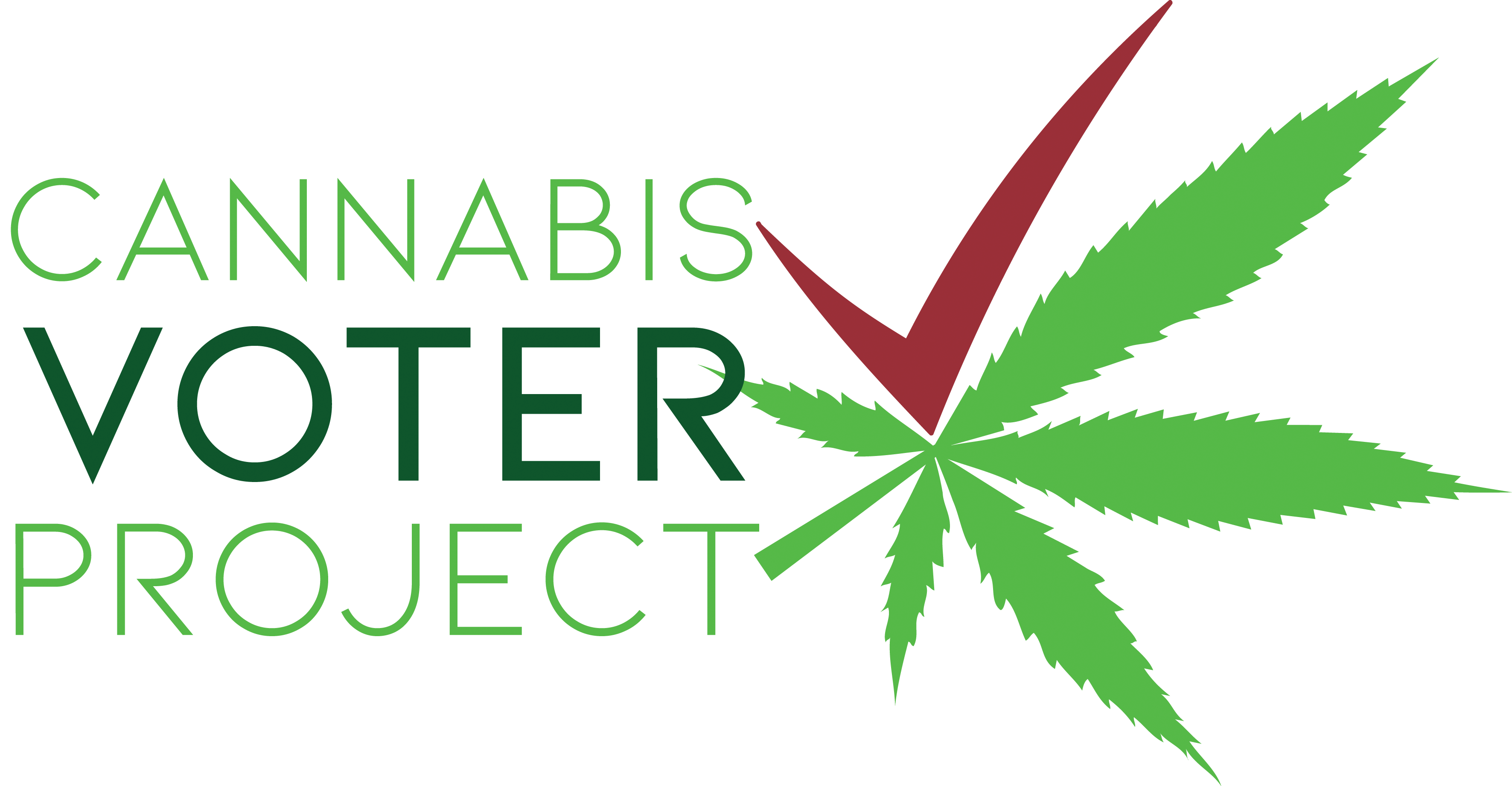
In an interview with HeadCount back in 2012, Bob Weir, founding member of the Grateful Dead, discussed the importance of registering to vote. “Just register, study up and vote. It’s your future. Don’t let people take that from you,” says Weir. “Cause in years to come you’ll be wishing you had.”
Tuesday, September 24th is National Voter Registration Day and we want to remind our readers to register to vote. If you subscribe to our newsletter, read our articles, news stories, columns and features, then chances are that you support legal cannabis. If you are supportive of legal cannabis, then you should consider voting for candidates that support the same cause. Cannabis legalization is about more than just creating a legal marketplace; it’s about social justice, equality, civil rights and more. If you can heal the symptoms, but not affect the cause, it’s quite a bit like trying to heal a gunshot wound with gauze.

The 2020 election is approaching faster than you think and choosing candidates that support legal cannabis is a quick and easy way to help. We really like what the Cannabis Voter Project (CVP) is up to. CVP is a nonprofit initiative started by HeadCount, an organization that promotes voter registration and participation in democracy through the power of music. This past summer, CVP went on tour with Dead & Co., engaging with concertgoers about registering to vote. Headcount has helped about 600,000 people register to vote so far. Bob Weir sits on their board of directors. Bands like Phish, Jay-Z, Dave Matthews, Pearl Jam have also helped get the word out about registering to vote as a part of HeadCount’s campaign.
You can register to vote or check your voter registration status by clicking here. You can also text CANNA to 40649 to contact your lawmakers and ask where they stand on cannabis. Once in a while you get shown the light, in the strangest of places if you look at it right. At the CVP’s website, you can check out their database of congress, organized state-by-state, with each members’ stance on cannabis.
Their advisory board features cannabis companies like CannaCraft, Terrapin Care Station, Harvest, Sal Pace Consulting, 1906 and Vicente Sederberg. They went on tour with funk band Lettuce to educate the band’s fans about what’s going on with cannabis policy in their state and how they can use their vote to impact cannabis policy.
Cannabis is a bipartisan issue. The cannabis voting bloc is bigger than you think and we have the power to make change happen by making our voices heard. “HeadCount is not so much political, it’s nonpartisan,” says Weir. “What we’re trying to do is get kids to register, pay attention to what candidates are saying, pay attention to the politics of the moment, and react with their hearts and minds.”
The cannabis legalization movement has made serious progress recently, but we still have to just keep truckin’ on.

According to a press release published earlier this week, A2LA announced the accreditation of two separate cannabis laboratories in two separate states; both are the first cannabis testing labs accredited in their states. Demeter Laboratory, based in Oklahoma City, Oklahoma, and Galbraith Laboratories, based in Knoxville, Tennessee, achieved the ISO 17025:2017 accreditation.
 According to Cassy VanTassel, M.S., quality manager at Demeter Laboratory, Oklahoma is still developing and defining their regulatory framework for cannabis testing requirements. “Even though the State of Oklahoma is still establishing regulations and legislation, Demeter will always strive to meet the highest quality standards, so our customers know they are getting the best quality testing,” says VanTassel. “Demeter chose A2LA as its Accreditation Body due to their reputation in the industry, their diverse clientele, and the quality of their assessors.”
According to Cassy VanTassel, M.S., quality manager at Demeter Laboratory, Oklahoma is still developing and defining their regulatory framework for cannabis testing requirements. “Even though the State of Oklahoma is still establishing regulations and legislation, Demeter will always strive to meet the highest quality standards, so our customers know they are getting the best quality testing,” says VanTassel. “Demeter chose A2LA as its Accreditation Body due to their reputation in the industry, their diverse clientele, and the quality of their assessors.”
 In Tennessee, Galbraith Labs is looking to aid the hemp industry in product safety testing. Christy Myers, customer service manager at Galbraith Laboratories, says they want to help farmers produce safe hemp products. “We are proud of our commitment to stay current within our industry and achieve the high standards set by A2LA,” says Myers. “Adding cannabis testing to our line of services was a great opportunity for Galbraith Laboratories to serve the community by helping farmers produce safe and legal hemp.”
In Tennessee, Galbraith Labs is looking to aid the hemp industry in product safety testing. Christy Myers, customer service manager at Galbraith Laboratories, says they want to help farmers produce safe hemp products. “We are proud of our commitment to stay current within our industry and achieve the high standards set by A2LA,” says Myers. “Adding cannabis testing to our line of services was a great opportunity for Galbraith Laboratories to serve the community by helping farmers produce safe and legal hemp.”
Galbraith Labs was founded in 1950 as a contract lab in Knoxville serving many industries. With their newly established accreditation, they hope to aid the cannabis industry in Tennessee with hemp testing. Demeter Laboratory is the first medical cannabis lab in Oklahoma. Their goals include “advancing quality controls in medical cannabis, supporting safe consumption of cannabis and ensuring the transparency of the cannabis community.”
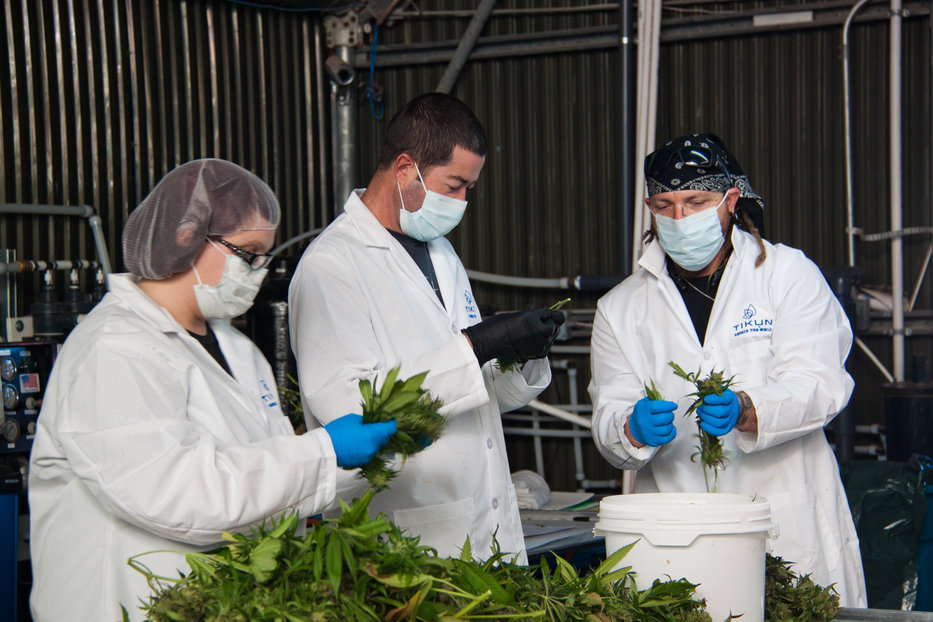
Mold is ubiquitous in nature and can be found everywhere.1 Cannabis growers know this all too well – the cannabis plant, by nature, is an extremely mold-susceptible crop, and growers battle it constantly.
Of course, managing mold doesn’t mean eradicating mold entirely – that’s impossible. Instead, cultivation professionals must work to minimize the amount of mold to the point where plants can thrive, and finished products are safe for consumption.
Let’s begin with that end in mind – a healthy plant, grown, cured and packaged for sale. In a growing number of states, there’s a hurdle to clear before the product can be sold to consumers – state-mandated testing.
So how do you ensure that the product clears the testing process within guidelines for mold? And what tools can be employed in biological warfare?
It helps to first understand how the cannabis plant becomes an optimal environment.
The cannabis flower was designed to capture pollen floating in the air or brought by a pollinating insect.

Once a mold spore has landed in a flower, the spore will begin to grow. The flower will continue to grow as well, and eventually, encapsulate the mold. Once the mold is growing in the middle of the flower, there is no way to get rid of it without damaging the flower.
The types of spores found in or around a plant can make or break whether mold will end with bad product.
Aspergillus for example, is a mold that can produce mycotoxins, which are toxic to humans2. For this reason, California has mandatory testing3for certain aspergillus molds.
Another example, Basidiospores, are found outside, in the air. These are spores released from mushrooms and have no adverse effects on cannabis or a cannabis cultivation facility.
Fungi like powdery mildew and botrytis (PM and Bud Rot) typically release spores in the air before they are physically noticed on plants. Mold spores like these can survive from one harvest to the next – they can be suspended in the air for hours and be viable for years.
Different types of spores – the reproductive parts of mold – get released from different types of mold. Similar to plants and animals, mold reproduces when resources are deemed sufficient.
The opposite is also true that if the mold is under enough stress, such as a depleting nutrient source, it can be forced into reproduction to save itself.4
In the end, mold spores are released naturally into the air for many reasons, including physical manipulation of a plant, which, of course, is an unavoidable task in a cultivation facility.5
Because of the almost-constant physical manipulation of plants that happen inside its walls, a grow’s trimming areas typically have the highest spore counts. Even the cleanest of plants will release spores during trimming.
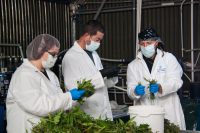
These rooms also have the highest risk for cross contamination, since frequently, growers dry flower in the same room as they trim. Plus, because trimming can be labor intensive, with a large number of people entering and leaving the space regularly, spores are brought in and pushed out and into another space.
The prevalence and ubiquitous nature of mold in a cannabis facility means that the fight against it must be smart, and it must be thorough.
By incorporating an upstream approach to facility biosecurity, cultivators can protect themselves against testing failures and profit losses.
Biosecurity must be all encompassing, including everything from standard operating procedures and proper environmental controls, to fresh air exchange and surface sanitation/disinfection.
One of the most effective tactics in an upstream biosecurity effort is fungal monitoring.
Determining the load or amount of mold that is in a facility is and always will be common practice. This occurs in a few ways.
Post-harvest testing is in place to ensure the safety of consumers, but during the growing process, is typically done using “scouting reports.” A scouting report is a human report: when personnel physically inspect all or a portion of the crop. A human report, unfortunately, can lead to human error, and this often doesn’t give a robust view of the facility mold picture.
Another tool is agar plates. These petri dishes can be opened and set in areas suspected to have mold. Air moves past the plate and the mold spores that are viable land on the dishes. However, this process is time intensive, and still doesn’t give a complete picture.
Alternatively, growers can use spore traps to monitor for mold.
Spore traps draw a known volume of air through a cassette.6 The inside of the cassette is designed to force the air toward a sticky surface, which is capable of capturing spores and other materials. The cassette is sent to a laboratory for analysis, where they will physically count and identify what was captured using a microscope.
Spore trap results can show the entire picture of a facility’s mold concerns. This tool is also fast, able to be read on your own or sent to a third party for quick and unbiased review. The information yielded is a useful indicator for mold load and which types are prevalent in the facility.
What’s going on inside of a facility has a direct correlation to what’s happening outside, since facility air comes infromthe outside. Thus, spore traps are most effective when you compare a trap inside with one set outside.
When comparing the two, you can see what the plants are doing, view propagating mold, and understand which of the spore types are only found inside.
Similar to its use in homes and businesses for human health purposes, monitoring can indicate the location of mold growth in a particular area within a facility.
These counts can be used to determine the efficacy of cleaning and disinfecting a space, or to find water leaks or areas that are consistently wet (mold will grow quickly and produce spores in these areas).
Utilizing spore traps for regular, facility-wide mold monitoring is advantageous for many reasons.
One example: Traps can help determine critical control points (CCP) for mold.
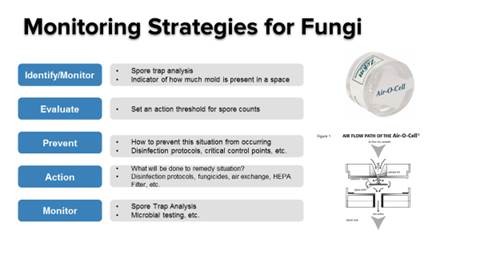 What does this look like? If the spore count is two times higher than usual, mitigating action needs to take place. Integrated Pest Management (IPM) strategies like cleaning and disinfecting the space, or spraying a fungicide, are needed to bring the spore count down to its baseline.
What does this look like? If the spore count is two times higher than usual, mitigating action needs to take place. Integrated Pest Management (IPM) strategies like cleaning and disinfecting the space, or spraying a fungicide, are needed to bring the spore count down to its baseline.
For example, most facilities will see a spike in spore counts during the times of initial flower production/formation (weeks two to three of the flower cycle).
Seasonal trends can be determined, as well, since summer heat and rain will increase the mold load while winter cold may minimize it.
Fungal monitoring – especially using a spore trap – is a critical upstream step in a successful IPM strategy. But it’s not the only step. In fact, there are five:
Each step must be followed to succeed in the battle against mold.
Of course, in the battle, there may be losses. If you experience a failed mandatory product testing result, use the data from the failure to fix your facility and improve for the future.
The data can be used to determine efficacy of standard operating procedures, action thresholds, and other appropriate actions. Plus, you can add a spore trap analysis for pre- and post- disinfection protocols, showing whether the space was really cleaned and disinfected after application. This will also tell you whether your products are working.
Leveraging all of the tools available will ensure a safe, clean cannabis product for consumers.
References